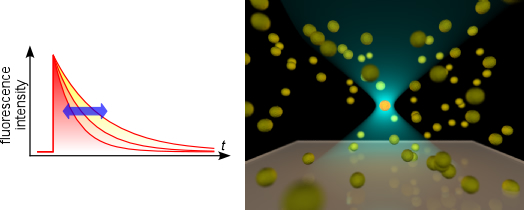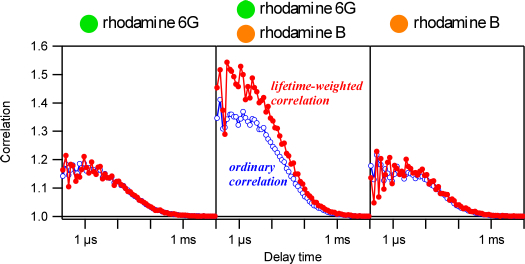Research topics
Development of a new correlation spectroscopic methods for observing fluorescence lifetime fluctuations
We have developed a new spectroscopic method, which we call lifetime-weighted fluorescence correlation spectroscopy, to study dynamics of complex molecules [1]. By utilizing FRET (Forster Resonance Energy Transfer), we can obtain structural information about complex molecules, such as biopolymers, via the fluorescence lifetimes of attached fluorescent probes. Our method is designed for observing structural diversity and fluctuations of complex molecules by continuously monitoring the fluorescence lifetimes of a few molecules in a microscopic volume. This idea is a straightforward extension of conventional fluorescence correlation spectroscopy (FCS).

Detection of fluorescence lifetime fluctuations by FCS
The figure below illustrates the potential of our method for detecting inhomogeneity of fluorescence lifetimes among molecules in a sample solution. Our method is also applicable to a temporarily fluctuating system, in which case it would be possible to capture the equilibration dynamics between distinct states, such as different conformations of complex molecules.

Detection of inhomogeneity by lifetime-weighted FCS
It is of particular importance in complex molecular systems to directly evaluate nontriggerable spontaneous dynamics ("asynchronous dynamics") on an experimental basis. While other single-molecule-based spectroscopic methods are frequently applied for this purpose, FCS is particularly useful for monitoring rapid processes in the nano- to microsecond time range. Therefore, our method has potential use in dynamical studies of complex molecules in very short timescales.
- [1] "Resolving inhomogeneity using lifetime-weighted fluorescence correlation spectroscopy", K. Ishii and T. Tahara, J. Phys. Chem. B 114, 12383-12391 (2010).
